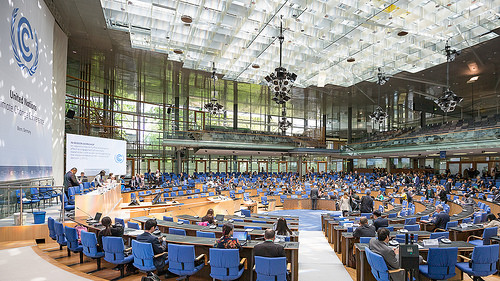
The Paris climate deal agreed in 2015 has set a new cycle for climate change policy. Among the several new mechanisms (many of which still to be settled down), the increasing engagement of non-Party stakeholders in the decision-making process it is a hallmark of the new course.
The recognition of the crucial role of non-party-stakeholders, such as academia and research institutions, NGOs, international agencies, local governments, and the private sector, has seen a decisive step change with the launch of the Talanoa dialogue at COP23 last year.
Named after the traditional word used in Fiji and across the Pacific to reflect a process of inclusive, participatory and transparent exchange, the Talanoa dialogue represents the first informal stocktake of countries’ climate pledges and efforts to be concluded during the next UNFCCC climate conference in Poland (COP24).
The assessment will be a crucial step for revising upwards national climate action plans needed to step up pre-2020 ambition and meet the long-term goals of the Paris Agreement.
The Talanoa dialogue seeks contributions from businesses, investors, cities, regions, civil society to respond to three key questions about the global effort to tackle climate change: where are we? Where do we want to go? How do we get there?
The inputs received through the dedicated portal will provide the substantive basis for ministerial negotiations at COP24 in Katowice this December.
Ahead of the mid-term UNFCCC talks taking place in Bonn from May 30 to May 10, the UNFCCC has made stock of the over 200 contributions and proposals sent so far.
According to the UNFCCC introductory overview, civil society and research organizations jointly account for half of the inputs received. Inputs by mixed partnerships and coalitions and the private sector account each for about 15 percent of the total contributions. The remaining is spread evenly across subnational governments, international organizations, Parties and groups of Parties, United Nations and UNFCCC constituted bodies.
One recurrent message arising from Talanoa contributions was that the scale and pace of climate action must increase dramatically, and immediately so if the world is to avert dangerous consequences of climate change. Present initiatives and efforts are considered to be not only insufficient to meet the goals of the Paris Agreement, but also inadequate to deliver on national pledges put forth by countries (NDCs).
While several inputs focus on the complex links between climate vulnerability, poverty and lack of development, many stressed the need to ensure that the way forward is for transitions and development paths that are just and inclusive, and consistent with human rights and equity.
A call for a more holistic approach integrating climate action in other international agendas (such as the 2030 Agenda for Sustainable Development and the Sendai Framework for disaster risk reduction) is a recurrent theme, as well as the need for broader and deeper collaboration at all levels. For instance, at the national level by increasing coordination among public and private actors to create better conditions for climate investment and technological innovation. Better vertically integrated governance is identified as a key factor to foster climate action at the sub-national level.
The process of defining the operational structure of the Paris Agreement presents many delicate issues, first of all, the pledge to agree on a comprehensive “rulebook” and a shared reporting system by the end of 2018. Other tangled cases include the promise of wealthier countries to provide at least USD100 billion a year in climate finance by 2020 and the enduring divide between developing and developed countries, which continue when it comes to defining commitments and responsibilities in climate action.
The Talanoa multilateral exercise is not likely to be sufficient to settle down the many issues at stake, but it can help strengthen the decisions to be taken. But time is running fast.
According to the co-chairs of the Ad Hoc Working Group in charge of clarifying the details on how the Paris Agreement should work in practice (APA), “given the breadth and complexity of the topics being addressed, we need to significantly increase the pace of work”.
Read more:
The Tanaloa dialogue portal: talanoadialogue.com
The UNFCCC overview of inputs to the Talanoa Dialogue (April 2018).
The UNFCCC website: unfccc.int


